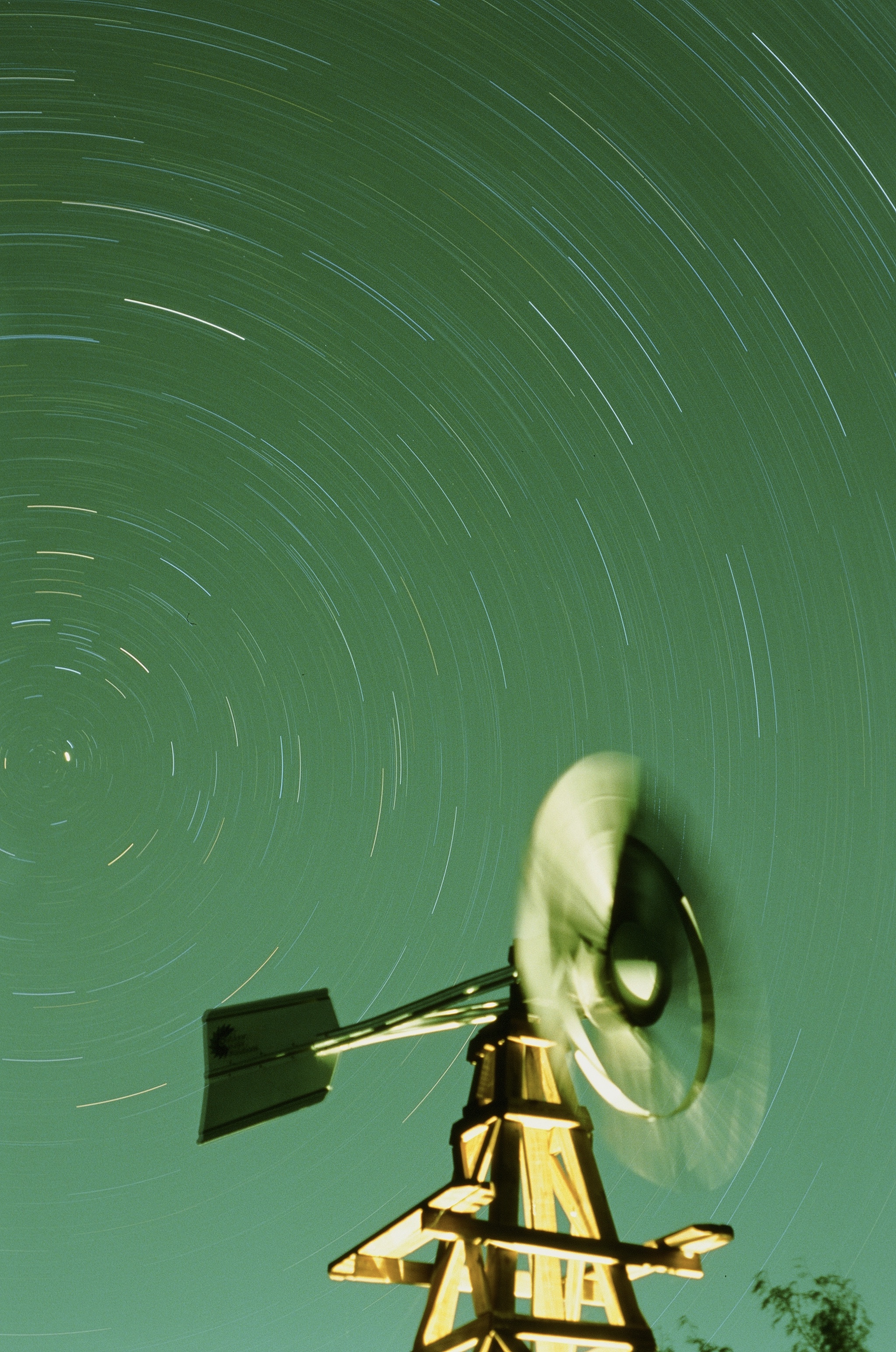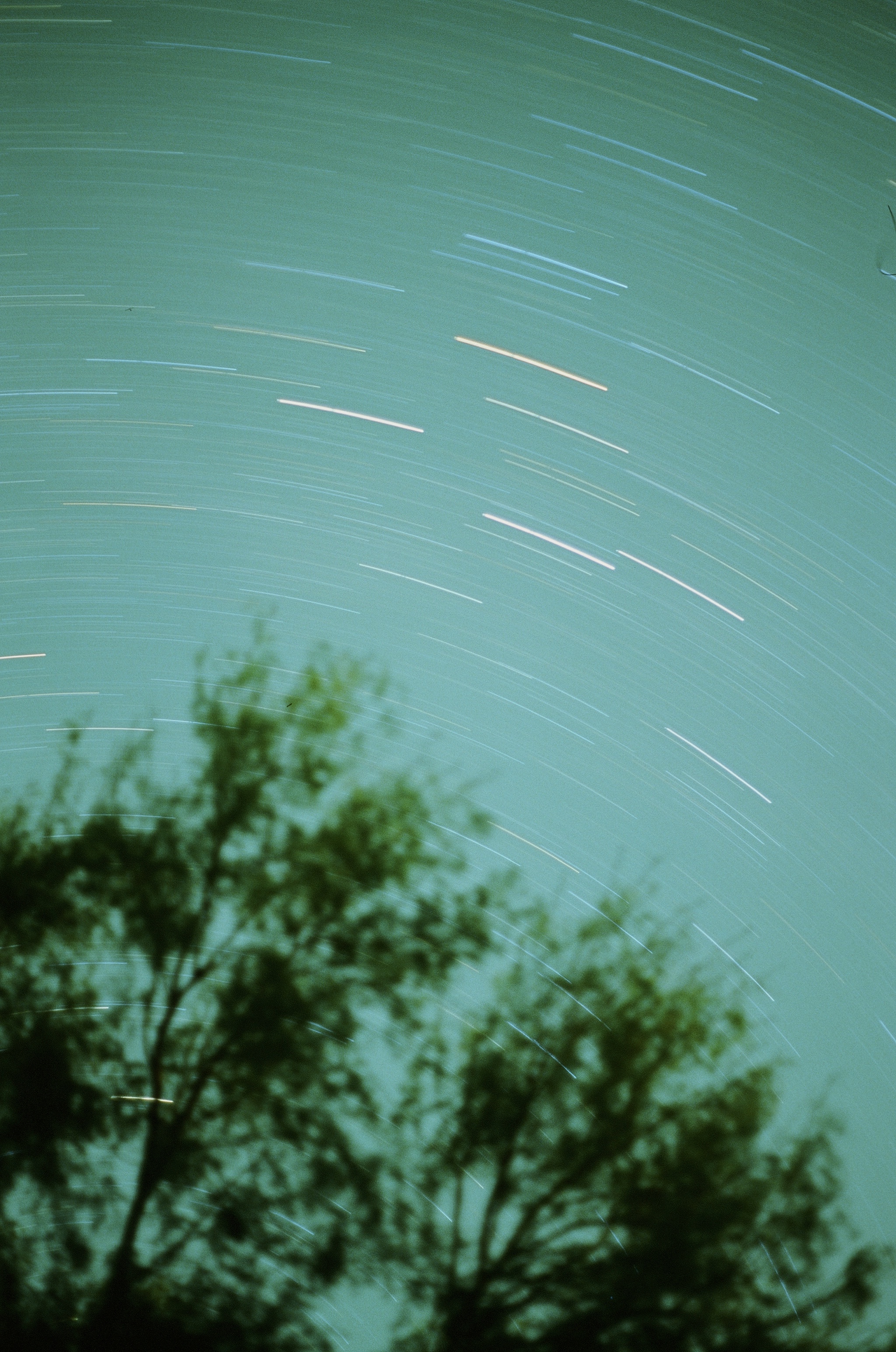Star Streaks on Film
This is my favorite one so far. Click image to get full-size.
Kodak Tri-X 400, Nikkor 5cm, f/4, 60 min.
I really liked how this one turned out. This was my first attempt and I didn't use a light meter
or anything so it was a complete guess but I think f/4 looks really good.
Strangely, you can see shadows from tree branches being projected up onto the side of the wall.
Also got this one:
Kodak Tri-X 400, Nikkor 5cm, f/1.8 (wide-open), 60 min.
Using the aperture wide-open here caused this shot to look the way it does. This lens is known for its "nervous" bokeh and falloff in the corners when wide-open. The extra brightness also caused the sky to be too bright and the stars aren't as clear. It worth noting that the sky was actually darker here than in the last photo. This one points away from the nearby city and the first one was angled towards it. So, using a 400 ISO film in an area that's about 4-4.5 on the Bortle scale, f/1.4 is too fast for hour-or-longer exposures.
A Useful Resource:
Since getting one of these requires such an investment of time that should be spent sleeping, I will plan out what to try ahead of time
and be sure to record the exposure parameters and results.
A big help in the planning is this website
which charts forecasted astronomy conditions. Here is an embedded chart from that website of the current forecast at a oberserving site
near my house:
 If I know I'll have time over a weekend, I can give this a glance on friday and see if/when there will be a good opportunity to make an
attempt.
If I know I'll have time over a weekend, I can give this a glance on friday and see if/when there will be a good opportunity to make an
attempt.
To record what I do (since I only develop film maybe once a month) I've been using ANALOGBOOK. It's
designed to record information about film photographs.

Update 11/29: EKTACHROME 100
I did it again, this time using the knowledge I gained and a much more expensive and riskier film, slide film.
Specifically Kodak Ektachrome E100. I also used my Pentax SLR instead of my Nikon rangefinder.
Here is the moneyshot (click that thang to get the full-size):

Kodak Ektachrome 100, Takumar Super-Multi-Coated 50mm, f/4, 62 min.
If you look closely you can see a trail from something blinking and moving straight across the sky. Either an airplane or satellite.
This one was the hardest to get, and I was upset when I closed the shutter because I thought there was no way it was going to work.
- I used the same exposure that worked last time(f/4 for 60 min), but the film is 4-times less sensitive!
- There are little solar-powered lamps under the windmill that were so dim when I set up that I didn't think about it. I thought it would make the whole frame overexposed / completely white!
- I thought I missed focus somehow. Either I focused on the windmill or something that I worried would make the interesting parts too blurry.
It's a miracle.
All these came out with a green sky like that. I don't know why.
I wonder why most stars are clearly either red or blue.
It turns out that f/4 is just better even with lower ISO films.
Here is one shot wide-open:

Kodak Ektachrome 100, Takumar Super-Multi-Coated 50mm, f/1.8(wide open), 60 min.
Color makes it a little better, but not enough contrast between the stars and the sky.
Also the falloff in the corners is just nasty here.
I took a few more, but they are all wide-open (I thought it was necessary with the lower ISO at the time) and
they're kinda uninteresting.
This one isn't of star trails but is kinda cool:
Kodak Ektachrome 100, Takumar Super-Multi-Coated 50mm, f/1.8(wide open), 20 sec.
That's the moon rising. I exposed wide-open aperture for 20 seconds. I was trying to get the red beacons on the
wind farm to show up. They sure did, but I think the whole image would be greatly improved by stopping down the
aperture.
Maybe it would need a longer time to get the beacons brighter, but the moon is super-bright and glaring. Looks like
the sun almost.
This roll took over a month to get developed, and the night sky conditions were not good for the second half of
October and most November.
I did take some more though the day I happened to get these scans delivered. I'll post another update once those are
eventually developed.
